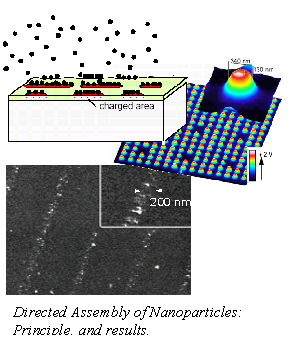ECS-0229087 CAREER: Directed Assembly of Nanoparticles;
A Tool to Enable the Fabrication of Nanoparticle
Based Devices
Ideas
![]()
![]() Highlighted on the cover page of Advanced Materials
Magazine, a newly invented Nanoxerographic printing technique at the
Highlighted on the cover page of Advanced Materials
Magazine, a newly invented Nanoxerographic printing technique at the  ward to Prof. Heiko O. Jacobs to
develop this area. Scientist from different disciplines benefit from the
integrative approach of education and research in nanoscience
and engineering that is supported by this program. The goal of the research
team is to develop a parallel tool to position nanoparticle
building blocks onto surfaces. The tool is based on directed self-assembly; it
uses a patterned surface with areas (receptors) that interact with nanoparticle-based device components. The first "Nanoxerographic" printer developed by the team
achieved 2 orders of magnitude higher resolution than traditional xerographic
printing. To enable the direct printing of nanoparticle-based
devices, the team will have to push this world record by another order of
magnitude.
ward to Prof. Heiko O. Jacobs to
develop this area. Scientist from different disciplines benefit from the
integrative approach of education and research in nanoscience
and engineering that is supported by this program. The goal of the research
team is to develop a parallel tool to position nanoparticle
building blocks onto surfaces. The tool is based on directed self-assembly; it
uses a patterned surface with areas (receptors) that interact with nanoparticle-based device components. The first "Nanoxerographic" printer developed by the team
achieved 2 orders of magnitude higher resolution than traditional xerographic
printing. To enable the direct printing of nanoparticle-based
devices, the team will have to push this world record by another order of
magnitude.